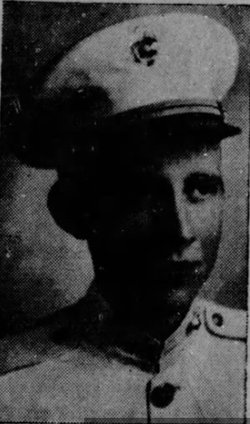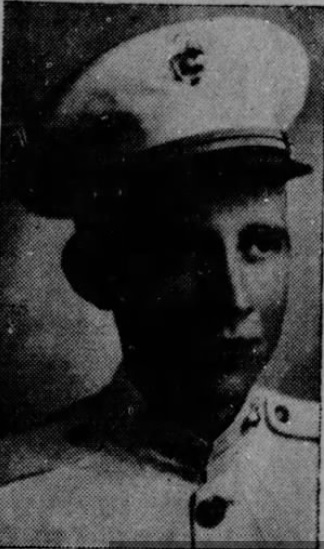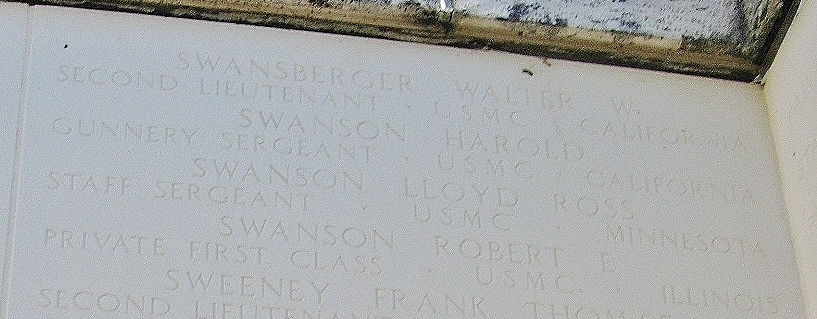Swansberger enlisted from California in 1941. He passed through aviator's elimination training and nearly a year of flight school before being awarded his wings and a commission as a second lieutenant.
On March 1, 1942, Lieutenant Swansberger was one of the Fighting Falcons chosen to form the basis of a brand new squadron, VMF-222, which was officially created on Eastern Island – right next door to Midway. (2) He started off flying a F2A-3 Brewster Buffalo in a strict training regiment as established by 221; in April, VMF-222 was recalled to Hawaii, but not before transferring all but two of their pilots to VMF-221.
Swansberger returned to the main island of Midway and, in late May, was fortunate to exchange his obsolete Buffalo for one of the newer F4F Wildcat fighters delivered by the USS KITTY HAWK. He flew Wildcat #3989 in the squadron's Fifth Division, under Captain John F. Carey.
On the morning of June 4, 1942, Swansberger took off at 0350 to fly a morning patrol with the rest of his division. An hour later, they were recalled to the island to rearm and refuel for what the command believed would be a major Japanese attack on the airfield.
Swansberger was still getting familiar with the Wildcat; new pilots often had trouble with the narrow landing gear, and Swansberger's plane ran off the taxiway and into the soft sand as he headed for the refueling revetment. As ground crews feverishly worked to dig the fighter out and assess any damage, Swansberger watched anxiously as the rest of his division took to the sky to meet the Japanese.
Finally, his aircraft was freed and Swansberger hurried to catch up. He was unable to locate his own division, so he tagged on with Captain Kirk Armistead's Third Division. Some of Armistead's pilots, in their older Buffalos, noticed the lone Wildcat tagging on to their division, and at least one recognized Swansberger's plane, Number 23. It was the last time he would be seen by anyone who survived – no trace of Walter or his Wildcat was found after the fight and he remains missing to this day.
Lieutenant Swansberger was awarded a Navy Cross Medal for his part in the battle. His citation reads as follows:
"The President of the United States takes pride in presenting the Navy Cross (Posthumously) to Walter W. Swanberger (0-7538), Second Lieutenant, U.S. Marine Corps (Reserve), for extraordinary heroism and distinguished service in the line of his profession while serving as a Pilot in Marine Fighting Squadron TWO HUNDRED TWENTY-ONE (VMF-221), Marine Air Group TWENTY-TWO (MAG-22), Naval Air Station, Midway, during operations of the U.S. Naval and Marine Forces against the invading Japanese Fleet during the Battle of Midway on 4 June 1942. Delivering a dauntless and aggressive attack against a vastly superior number of Japanese bomber and fighter planes, Second Lieutenant Swanberger aided in disrupting the plans of the enemy and lessening the effectiveness of their attack, thereby contributing materially to the success of our forces. As a result of his courageous and daring tactics and because of the circumstances attendant upon this engagement, three can be little doubt that Second Lieutenant Swanberger gallantly gave up his life in the service of his country. He displayed the characteristics of an excellent airman in keeping with the highest traditions of the United States Naval Service."
At the time of his death, his parents were living at
Second Lieutenant Walter W. Swansberger, Sn#O-007538, earned the following badges/decorations for his service to the United States Marine Corps prior to and during World War II:
- Gold Navy Pilot's Wings
- Navy Cross Medal
- Purple Heart Medal
- Combat Action Ribbon
- Presidential Unit Citation Ribbon
- American Defense Service Medal
- Asiatic-Pacific Theater of Operations Campaign Medal with one bronze battle star
- World War II Victory Medal
Swansberger enlisted from California in 1941. He passed through aviator's elimination training and nearly a year of flight school before being awarded his wings and a commission as a second lieutenant.
On March 1, 1942, Lieutenant Swansberger was one of the Fighting Falcons chosen to form the basis of a brand new squadron, VMF-222, which was officially created on Eastern Island – right next door to Midway. (2) He started off flying a F2A-3 Brewster Buffalo in a strict training regiment as established by 221; in April, VMF-222 was recalled to Hawaii, but not before transferring all but two of their pilots to VMF-221.
Swansberger returned to the main island of Midway and, in late May, was fortunate to exchange his obsolete Buffalo for one of the newer F4F Wildcat fighters delivered by the USS KITTY HAWK. He flew Wildcat #3989 in the squadron's Fifth Division, under Captain John F. Carey.
On the morning of June 4, 1942, Swansberger took off at 0350 to fly a morning patrol with the rest of his division. An hour later, they were recalled to the island to rearm and refuel for what the command believed would be a major Japanese attack on the airfield.
Swansberger was still getting familiar with the Wildcat; new pilots often had trouble with the narrow landing gear, and Swansberger's plane ran off the taxiway and into the soft sand as he headed for the refueling revetment. As ground crews feverishly worked to dig the fighter out and assess any damage, Swansberger watched anxiously as the rest of his division took to the sky to meet the Japanese.
Finally, his aircraft was freed and Swansberger hurried to catch up. He was unable to locate his own division, so he tagged on with Captain Kirk Armistead's Third Division. Some of Armistead's pilots, in their older Buffalos, noticed the lone Wildcat tagging on to their division, and at least one recognized Swansberger's plane, Number 23. It was the last time he would be seen by anyone who survived – no trace of Walter or his Wildcat was found after the fight and he remains missing to this day.
Lieutenant Swansberger was awarded a Navy Cross Medal for his part in the battle. His citation reads as follows:
"The President of the United States takes pride in presenting the Navy Cross (Posthumously) to Walter W. Swanberger (0-7538), Second Lieutenant, U.S. Marine Corps (Reserve), for extraordinary heroism and distinguished service in the line of his profession while serving as a Pilot in Marine Fighting Squadron TWO HUNDRED TWENTY-ONE (VMF-221), Marine Air Group TWENTY-TWO (MAG-22), Naval Air Station, Midway, during operations of the U.S. Naval and Marine Forces against the invading Japanese Fleet during the Battle of Midway on 4 June 1942. Delivering a dauntless and aggressive attack against a vastly superior number of Japanese bomber and fighter planes, Second Lieutenant Swanberger aided in disrupting the plans of the enemy and lessening the effectiveness of their attack, thereby contributing materially to the success of our forces. As a result of his courageous and daring tactics and because of the circumstances attendant upon this engagement, three can be little doubt that Second Lieutenant Swanberger gallantly gave up his life in the service of his country. He displayed the characteristics of an excellent airman in keeping with the highest traditions of the United States Naval Service."
At the time of his death, his parents were living at
Second Lieutenant Walter W. Swansberger, Sn#O-007538, earned the following badges/decorations for his service to the United States Marine Corps prior to and during World War II:
- Gold Navy Pilot's Wings
- Navy Cross Medal
- Purple Heart Medal
- Combat Action Ribbon
- Presidential Unit Citation Ribbon
- American Defense Service Medal
- Asiatic-Pacific Theater of Operations Campaign Medal with one bronze battle star
- World War II Victory Medal
Gravesite Details
Entered the service from California.
Family Members
Sponsored by Ancestry
Advertisement
Advertisement











